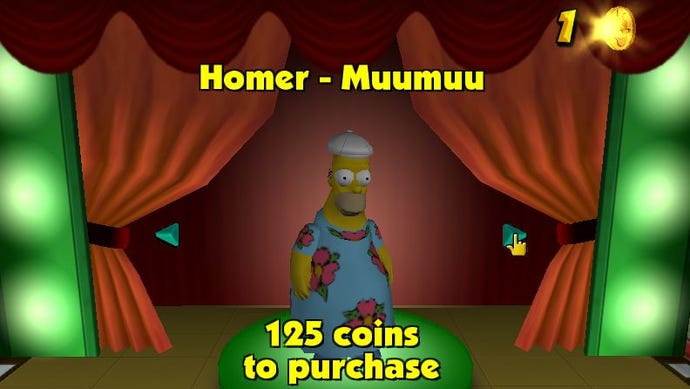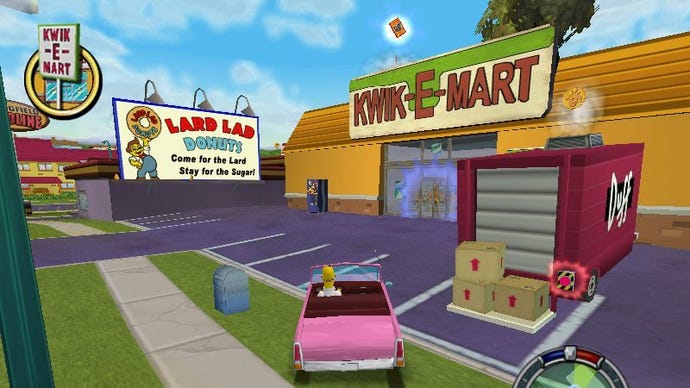Why everyone still loves a 20-year-old Simpsons game
The Simpsons: Hit & Run was the show's 22nd game adaptation, but it's the one that lasted
In another reality, 2003's The Simpsons: Hit & Run — an action-adventure game that was by then the show's 22nd video game adaptation — might have slid quietly into obscurity. So why is it, then, that we can't seem to let it go? On YouTube, the game frequently resurfaces via longplays, speedruns, and retrospective essays that garner respectable amounts of views year after year. A few months ago, the game's lead designer told GamesRadar that he would support an official remake, mentioning that Hit & Run continues to be The Simpsons' most popular video game adaptation on Metacritic.
Yet Hit & Run's sustained relevance is, on its surface, a bit of an enigma. You'd be hard-pressed to find the game included in any critical canons or best-of lists, and there's hardly been a shortage of T-rated open-world games since its release. But for many, the game isn't just a source of nostalgia today; it was an introduction to a wholly new form of in-game self-expression. I looked into the still-growing community keeping it alive today.
When I was younger, still damp with a listless, pre-teen sadness, I spent my afternoons in Hit And Run's virtual Springfield. I drove in restless laps through the neon green bowels of the nuclear power plant; I took scenic cruises up to the Springfield Observatory in Bart's "Ferrini," a syrupy sunset glued to the horizon. For many children whose parents had deemed them too innocent to play Rockstar's Grand Theft Auto III, The Simpsons: Hit & Run was an outlet for a hushed longing to participate in the open-world revolution. As the series' first fully 3D title, GTA III — along with 2002's GTA: Vice City and 2004's GTA: San Andreas — would balloon that series into a cultural phenomenon, setting a benchmark for how comprehensively a game could simulate a world bustling with life.

By the time I'd grown up and cobbled together enough cash to purchase a PS4 and a copy of GTA V, I considered Hit & Run a sentimental artifact from a wistful past. Yet as I advanced through GTA V, I pictured myself swerving across Springfield's boardwalk in Lisa's Malibu Stacy Car. I figured I was alone in this. YouTube quickly proved me wrong, yielding Hit and Run videos whose view counts number in the millions - but I couldn't understand why. Despite the design lead's enthusiasm, Hit & Run has not received an official remake, and it takes effort to get the game to run properly on modern PCs.
Then I discovered Hit & Run's extensive modding scene. Two channels in particular have found success in translating Hit & Run for the modern era: El Gato Del Trejado, who produces videos featuring their own Hit And Run "remastered mod," and Reubs, whose "remake" project made headlines when it was completed last month. Though not publicly playable, Reubs' remake is an immaculate reimagining of Hit & Run in the Unreal Engine. Like me, Reubs discovered Hit & Run in his youth. "I had a pretty unsettled childhood and video games were a great escape," Reubs tells me. "I would sit there for hours and get completely lost in them."
GTA III re-contextualised in-game violence. No longer solely a means of overcoming challenges or gaining progress, it was also the primary way to interact the game environment. A player could shoot or run over a majority of the NPCs they encountered, making small spectacles out of every car explosion or police shootout. But moral panics plagued GTA's ascent to popularity, often centred on its sexual and violent content. These controversies came to a head when PS2 modders found a hidden minigame crudely simulating sex in San Andreas' code. For some parents, the violence was already pushing it. The promise of low-poly pornography, however, crossed a line.
There was always, however, Hit & Run.
Radical Entertainment's Simpsons-themed interpretation of the GTA III formula is violent yet bloodless, funny but never R-rated. In 2003, it was the perfect GTA substitute for concerned parents — the original "we have GTA at home." Hit & Run's Springfield is replete with references to the series' first twelve seasons. Landmarks like Moe's Tavern, the Springfield Nuclear Power Plant, and the Kwik-E-Mart contain explorable interiors rich with gags, while a litany of characters from the show’s notoriously extensive cast act as quest-giving NPCs.
The game's roster of vehicles represents a catalogue of references in itself, giving players the chance to drive cars like Mr. Plow (season 4, episode 9) or Marge's Canyonero (season 10, episode 15). The dialogue — written by members of The Simpsons' writers' room and delivered by the original cast — contains both original quips and memorable one-liners from past episodes. Though stringent copyright laws often limit the scope of fan remakes, Reubs' was lucky in that he didn't have to code from scratch. "Hit & Run has a huge modding community, and their tools made it incredibly easy to do this," Reubs says. "Without them I probably never would have attempted the remake in the first place."
The most prominent Hit & Run modding organization is Donut Team, who operate a forum and Discord server dedicated to sharing and celebrating fanmade Hit & Run content. In addition to showcasing their main project — "Project Donut", a mod that includes original missions, vehicles, and characters — the forums also provide aspiring modders with a variety of tools.

Donut Team have produced a staggering number of Hit & Run mods over the years. Some of the most ambitious projects include Annoy Squidward, which swaps The Simpsons out for Spongebob Squarepants; More Costumes, which includes over a hundred hand-designed costumes constituting references to the show; and the in-progress Futurama: Hit & Run, a total conversion mod that takes place in Futurama's New New York.
Though Donut Team was founded a decade ago, Jake, one of the organisation's founding members, estimates they receive 50-100 new members a day. "With a forum, you see years of expertise, discussion and creativity build and grow," he says. "That’s something that we deeply miss about the older internet."
Nostalgia unites the Donut Team community. For users who exited adolescence knowing virtual Springfield like the back of their banana-toned hand, Hit & Run mods have become a way of turning an old haunt into a site for self-expression. "It's a way of changing a world you already love," Donut Team member Evie tells me.
This is perhaps the reason why the community's mods rarely deviate from Hit & Run's T-rated approach to violence. While some mods may attempt to address modern expectations of open-world games — QoL improvements like a "fully connected" map or updated UI elements — most of them adhere to Hit & Run's mission structures, telling new stories in the form of races and time trials rather than assassinations or bloody bank heists gone awry. To mod Hit & Run with this kind of new content is to reevaluate what made the game unique as a sandbox storytelling engine.

Hit & Run's sustained popularity in the world of modding grants clarity to the yearning that I and many of my generational peers harboured back when GTA III was a forbidden text. The violence was only ever one half of the equation; Hit & Run compensated for its lack of guns by focusing on its vehicles, making them the game's primary means of self-expression. In the age of Elden Ring and The Legend Of Zelda: Tears Of The Kingdom, the open-world genre has expanded to encapsulate a number of different settings and ideas. No longer are non-linear, fully explorable 3D worlds beholden to stories about organised crime and virtual dioramas of real-world metropoles.
I've slaughtered countless cowboys trekking through Read Dead Redemption 2's Lemoyne County. I've dismembered a dystopia's worth of biohackers in Cyberpunk 2077's Night City. But I'll never forget the hours I spent crashing through Evergreen Terrace in the Simpsons' family sedan, a neighborhood I almost knew better than my own.
